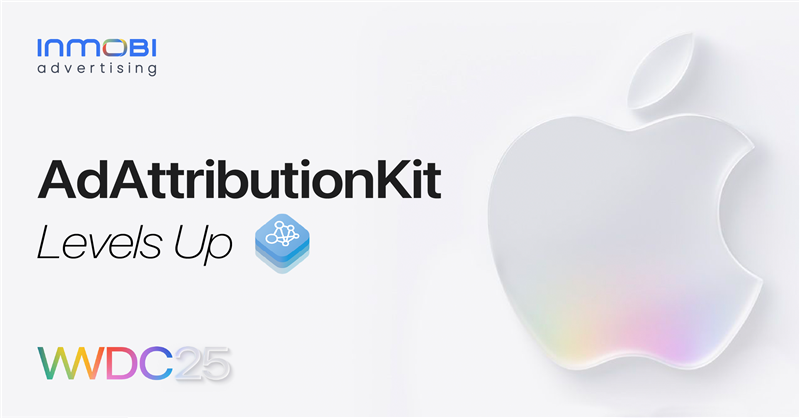- Acquiring New Users
- Advertising
AdAttributionKit Leveled Up with iOS 18.4 Updates

2At WWDC 2025, Apple unveiled the next set of upgrades to AdAttributionKit (AAK), giving iOS marketers more tools to measure performance in a privacy-first world. Rolling out with iOS 18.4, these updates include overlapping conversion windows, configurable attribution windows and cooldowns, geo-level postback data, and improved testing capabilities.
Since its announcement with iOS 17.4 as the successor to SKAdNetwork 4.0 (SKAN 4.0), AAK has steadily evolved—most notably by enabling re-engagement measurement. With this latest release, Apple addresses many of the remaining gaps that have limited iOS app marketers from fully embracing SKAN.
Still, more flexibility means more complexity. These features aren’t plug-and-play and will require thoughtful setup-making the right partner essential. From tuning attribution settings to interpreting overlapping conversions, adapting to AAK's capabilities is key to unlocking its full potential.
Before diving into what’s new, let’s quickly revisit how attribution worked under SKAdNetwork.
SKAdNetwork (SKAN) enabled privacy-safe attribution by sending limited postback data without relying on device identifiers. A typical SKAN flow involved a user viewing and interacting with an ad served by a network, followed by an app install. If that happened, SKAN would trigger a delayed postback containing anonymized campaign and conversion data. While SKAN 4.0 introduced improvements such as multiple postbacks and coarse conversion values, it still lacked flexibility, particularly around re-engagement tracking, conversion window configuration, and access to granular insights like location data.
Source- Apple WWDC 2025
Now with latest AAK update, those barriers are starting to fall. Here’s what’s changed, and what it means for advertisers navigating Apple’s evolving privacy framework.
Five Key Updates That Change the Game
Smarter Re-engagement Tracking with Overlapping Conversion Windows
One of the most impactful changes in iOS 18.4’s AAK is support for overlapping re-engagement conversion windows-a major leap forward in accurate attribution for performance marketers.
Previously, apps could track only one active re-engagement conversion at a time. Now, with overlapping windows, you can run multiple simultaneous re-engagement campaigns—each tied to its own conversion path. Apple enables this through conversion tags, which act like bookmarks to identify and update the right conversion, even if a user interacts with multiple ads over time.
To enable this capability, developers must set the ‘EligibleForAdAttributionKitOverlappingConversions’ key to ‘YES’ in the app’s ‘Info.plist’. Once opted in, conversion tags are appended to the re-engagement URLs. These can be extracted, stored (locally or server-side), and later used to update the corresponding conversion directly using the Postback API—ensuring the right campaign gets credit for driving the desired action.

Source-Apple WWDC 2025
What this means for advertisers
For advertisers, overlapping re-engagement windows offer sharper attribution and clearer insight into multi-touch journeys. Actions can now be tied back to the specific ad that drove them, even if users interact with multiple campaigns. This enables more accurate ROI measurement, smarter optimization, and the freedom to run parallel promotions without losing attribution clarity.
Smarter Attribution with Customizable Windows
Attribution doesn’t have to be one-size-fits-all anymore. Apple now allows advertisers to define how long an ad remains eligible for conversion-tailoring attribution windows by ad network and interaction type. You can even exclude specific interaction types from select networks using the ‘ignoreInteractionType’ key, or apply global rules that adapt with more precision across campaigns.
What this means for advertisers
This added flexibility helps match attribution logic to actual user behaviour, whether that’s same-day purchases or longer decision paths. The result: better signal quality and more meaningful performance insights. Based on global benchmarks, InMobi recommends a 7-day click-through and 1-day view-through window-a setup proven to balance intent capture with measurement accuracy.
Configurable Attribution Cooldowns to Avoid Double-Counting
One of the biggest pain points in iOS attribution has been overlap-especially when retargeting ads claim credit for conversions already influenced by earlier campaigns. Think of a user who installs your app after tapping an ad, but before they make a purchase, they click on a second re-engagement ad. Without clear controls, attribution can unfairly shift to the second touchpoint, misrepresenting true campaign performance.
With iOS 18.4, Apple introduces configurable cooldowns-a simple yet powerful fix. You can now define a pause period after a conversion event (like an install or re-engagement), during which new ad interactions won’t be attributed. This gives marketers the ability to protect the value of key touchpoints and avoid cannibalization between user acquisition and retargeting efforts.
What this means for advertisers
By minimizing attribution noise and giving weight to the original source of influence, cooldowns offer a clearer picture of what’s actually driving results. As a leading SKAN-enabled DSP, InMobi is poised to help advertisers make the most of this update-ensuring the right setup, avoiding overlaps, and preserving the integrity of performance insights across the user journey.
Geography Data for Smarter Optimization
Until now, AdAttributionKit postbacks-the conversion outputs containing attribution and engagement data-have provided zero geography insights, forcing networks and developers to rely on workarounds like source identifiers. With iOS 18.4, AdAttributionKit adds country codes to postbacks-giving advertisers clearer geographic context without compromising privacy. The country is derived from the App Store storefront or verified via install tokens, and included only when Apple’s crowd anonymity thresholds are met.
What this means for advertisers
Better geo-level visibility means sharper campaign decisions-whether you’re localizing creatives, managing region-specific budgets, or measuring performance across markets. And since geo data is now provided natively, you can free up source identifiers that were previously used for country-level tracking. InMobi helps you translate this signal into smarter targeting and reporting across borders.
Developer-Friendly Testing at Last
iOS 18.4's built-in development postback creation through Settings eliminates the painful testing cycles that have plagued SKAN implementations. Configure test scenarios directly on device with adjustable data granularity and distinct signature keys for easy identification.
Source-Apple WWDC 2025
Fingerprinting Protections Tighten in Safari
While most of the spotlight at WWDC 2025 was on AdAttributionKit, Apple also introduced a quiet but important shift in Safari 26—significantly strengthening its stance against browser fingerprinting. These updates aim to eliminate common web-based tracking workarounds that advertisers and analytics platforms have long relied on.
Safari will now block access to several fingerprinting surfaces, such as screen size, canvas APIs, and speech synthesis. It also disables persistent storage methods like cookies and localStorage, and strips click-tracking parameters (e.g., gclid, fbclid) from URLs—even outside Private Browsing mode.
What this means for advertisers
For marketers relying on web-to-app flows; such as landing pages or deferred deep linking-these protections reduce the ability to deterministically attribute users unless SKAN or deep link matching is in place. It also limits fallback fingerprinting used by some attribution providers when SKAN fails or isn’t supported. The message is clear: web-based identity stitching is being phased out in favour of privacy-safe, platform-native attribution.
The privacy-preserving attribution era is here. Is your growth engine ready?
With Apple handing advertisers the controls they’ve long wanted-greater clarity, flexibility, country-level insight, and now even stronger browser fingerprinting protections—AdAttributionKit and Safari 26 updates mark a clear turning point. This isn’t just evolution; it’s a complete ecosystem reset.
To thrive in this new environment, you need a partner who’s not merely aware, but already built for it. At InMobi, we’ve been pioneering SKAN-first performance since day one—building the industry’s first SKAN bidder, integrating deeply with MMPs, and crafting intelligence around privacy-safe contextual signals.
Safari’s fingerprinting upgrades underscore the shift: deterministic web identifiers are being phased out, and measurement must adapt accordingly. That’s why InMobi has been investing in privacy-compliant modelling, deterministic SKAN logic, and contextual optimization to ensure your campaigns remain measurable, scalable, and future-proof.
The infrastructure is ready. The opportunity is real. With InMobi DSP, your growth engine is already aligned with the future.
Looking to dive deeper into SKAN? Check out our library of expert-backed guides, case studies, and thought leadership that decode the complexities of SKAN and help you drive performance in a privacy-first world. Whether you're just starting or scaling, these resources are built to support every step of your iOS marketing journey:
Stay Up to Date
Register to our blog updates newsletter to receive the latest content in your inbox.






